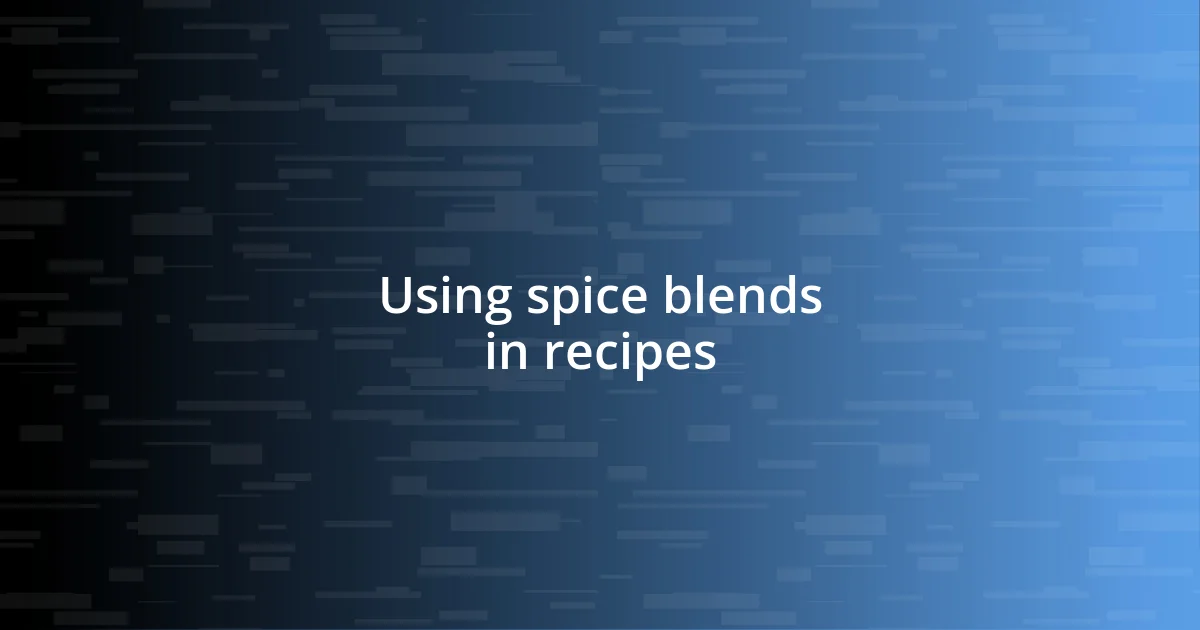Key takeaways:
- Understanding the balance of flavors, including sweetness, heat, and earthiness, is crucial in creating effective spice blends.
- Quality of spices significantly impacts flavor, with whole spices providing more potency and longer shelf life compared to pre-ground options.
- Proper storage in airtight containers away from heat and moisture preserves the freshness and potency of spice blends over time.

Understanding spice blend basics
When I first started experimenting with spice blends, I was amazed by how even a small amount could transform a dish. It’s all about balance; you want to harmonize flavors—sweet, savory, spicy, and earthy—so they complement rather than overwhelm each other. Have you ever tried a dish that was just too salty or not spicy enough? It really drives home the point that understanding the foundational flavors is crucial.
Consider the primary spices in a blend, like cumin, coriander, or paprika. Each has its own distinct character, which can either shine through or take a backseat, depending on how you combine them. Early in my culinary journey, I learned the hard way that too much of one spice could mask the subtle nuances of another, leaving my blend flat. It was frustrating, but it taught me to respect the individual roles each spice plays in the overall flavor profile.
Texture is another factor I overlooked initially. I remember trying to create a coarse blend without considering how the consistency affects the mouthfeel of dishes. It’s fascinating how this simple aspect can elevate the dining experience. Think about it: a finely ground spice can disappear into a dish seamlessly, while coarser pieces might add unexpected bursts of flavor. What textures do you enjoy in your meals? Understanding spice blends is not just about ratios; it’s about crafting a full experience.

Selecting quality spices
Selecting quality spices is a game changer in creating successful spice blends. I vividly remember the first time I visited a specialty spice shop. The aroma hit me like a wave, and each jar promised a burst of flavor. I learned that freshness is key; spices lose their potency over time. Purchasing spices from a reputable source ensures that I get the most vibrant flavors possible for my blends.
When I think about the quality of spices, I can’t help but compare whole spices to pre-ground ones. Whole spices tend to have a longer shelf life and often pack more flavor punch when freshly ground. I recall using whole coriander seeds in a batch of my homemade curry blend. The difference was astonishing compared to the pre-ground version I used before. Freshly ground spices add an unmatched depth to dishes, making the effort worthwhile.
Another essential aspect is the appearance and aroma of the spices. Evaluating their color and fragrance can be quite revealing. I once opened a jar of turmeric and was greeted by a muted shade and a faint scent. That experience taught me to trust my senses; vibrant colors and strong aromas are indicators of quality. How often do you pay attention to these details while selecting your spices?
| Spice Type | Quality Indicator |
|---|---|
| Whole Spices | Longer shelf life, stronger flavor when freshly ground |
| Pre-ground Spices | Possible loss of flavor over time |
| Appearance | Vibrant color is a sign of freshness |
| Aroma | Strong scents indicate quality |

Common spice blend components
Understanding common components of spice blends is key to creating unique flavors. Each ingredient brings something special to the table. For instance, herbs often add freshness, while seeds introduce depth and warmth. I remember the first time I used fenugreek in my blend; the sweet, slightly nutty flavor took my curry to another level. It’s those moments of discovery that make experimenting so rewarding.
Here’s a quick list of common spice blend components to consider:
- Herbs (e.g., basil, oregano, thyme) – Fresh and aromatic, they brighten dishes.
- Seeds (e.g., cumin, mustard, coriander) – They add earthy depth and complexity.
- Chili Peppers (e.g., cayenne, chipotle) – These provide varying degrees of heat.
- Roots (e.g., ginger, garlic) – They lend zesty or pungent notes, enhancing flavor.
- Spices (e.g., turmeric, cinnamon) – Often used for their color and unique fragrances.
Combining these elements can be an art form. It reminds me of my first homemade garam masala. I was hesitant at first but decided to blend whole spices like cardamom and cloves. The aroma that filled my kitchen was intoxicating and made me realize how integral each component is to the final flavor. Each spice has a story—learning to blend them is like composing a symphony where all the notes align perfectly.

Creating balanced flavor profiles
Creating a balanced flavor profile is all about harmony among the different elements in your spice blend. I still remember the first time I experimented with turmeric and cardamom together; the contrast and complement of their flavors was mesmerizing. It made me realize that achieving balance often requires a dance between sweetness, heat, acidity, and earthiness. Have you found a combination that surprised you in a good way?
Another thing I’ve learned is to create layers of flavor by adjusting the proportions of each ingredient. At one point, I was making a chili blend for a gathering and added too much cayenne pepper. While it didn’t ruin the dish, the heat overshadowed the other flavors. From that experience, I understood the importance of starting with smaller amounts, then gradually adjusting until the blend sings in unison. How do you usually determine the right balance?
I also believe that tasting as you go is crucial. It’s almost like a conversation between you and your spices. I’ll never forget the moment when I first tasted my homemade za’atar blend after adjusting the lemon zest and sumac. The difference was night and day! This iterative process creates that perfect flavor profile that excites the palate. Have you tried this approach in your cooking?

Practical tips for blending spices
When blending spices, it’s essential to toast whole seeds to bring out their full flavor potential. I remember the first time I tried this technique. The fragrant aroma of toasting cumin and coriander seeds took my breath away, transforming my kitchen into a spice heaven. Have you ever experienced such a delightful moment while cooking?
Another tip I’ve found invaluable is to keep your blends simple at first. Starting with a few key spices allows you to hone in on what each ingredient contributes to the mix. I once created a blend with just garlic powder, black pepper, and smoked paprika, and surprisingly, it enhanced a simple roast chicken fabulously. It taught me that sometimes less truly is more. What simple combinations have you enjoyed in your cooking?
Lastly, always consider the freshness of your spices. I’ve learned the hard way that using stale spices can lead to lackluster blends. One day, I made a batch of spice mix with some old paprika, and it fell flat. Now, I make it a point to check my pantry before blending, and I even enjoy visiting local spice shops to grab fresher options. How do you ensure your spices remain fresh?

Storing and preserving spice blends
Storing your spice blends properly can significantly enhance their shelf life, which I’ve found to be crucial in maintaining flavor. I typically use airtight glass jars because they create a seal that keeps moisture and light at bay—the natural enemies of spice potency. Every time I open one of these jars, I can smell the vibrant aromas, reminding me of how fresh my blends still are. What do you think your spices smell like after a few months if they’re not stored correctly?
I also make it a habit to label each jar with the date I blended it. It’s a simple practice, but it has saved me so many times from using a blend that had long lost its zing. The other day, I opened a jar of garam masala that I had blended four months earlier, and I could immediately tell it was still vibrant. Have you ever been surprised by how long your spice blends can last when stored correctly?
Finally, I encourage you to store your blends in a cool, dark place, far from your stove and refrigerator. Heat and humidity can quickly degrade the quality of your spices. Once, I had a blend of taco seasoning that I stored above the stove. After a few months, it lost its flavorful punch because of the heat. Lesson learned! Where do you keep your favorite blends to ensure they stay fresh?

Using spice blends in recipes
Spice blends are incredibly versatile, and I often find myself experimenting with them to elevate everyday dishes. For instance, adding a dash of my homemade za’atar blend to roasted vegetables can completely transform their taste, giving a fresh, herby kick that’s simply irresistible. Have you ever tried enhancing a dish with a spice blend and been amazed at how a few sprinkles can make such a difference?
When using spice blends in recipes, I like to start by incorporating them into marination processes. A memorable experience was when I marinated chicken with a turmeric and cumin blend overnight. The next day, the flavors had seeped deep into the meat, creating a deliciously golden and fragrant dish. What marinating adventures have you had with your spice blends?
A great tip I recommend is to sprinkle some spice blend into your soups or sauces as they simmer. I remember the first time I stirred a homemade curry powder blend into a simmering pot of lentil soup. The aroma that filled my kitchen was mouthwatering, reminding me why cooking with my own blends is so rewarding. Have you discovered how a simple addition can change the whole vibe of your dish?














